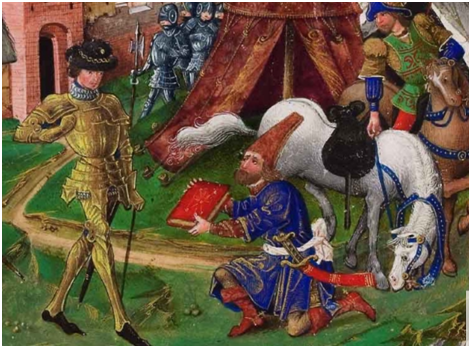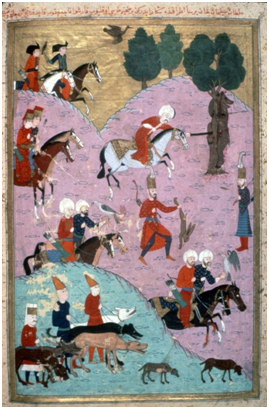
Scholars have long shared the fascination with which medieval and early modern people watched the movements of animals around the Mediterranean. And, while not as large as the elephants or as rare as the giraffes and rhinoceroses, horses were also symbolically rich. Frequently traded and paraded, they were vital contributors to the production of royal spectacle.
This equine enthusiasm unfolded “on a continental scale” and united elite tastes in a shared idiom of courtly hunting.[1] While horses thus circulated as one of the most universally appreciated diplomatic gifts, practices related to riding, training, and breeding could nonetheless differ considerably. Betrandon de la Broquière, a European nobleman who undertook a diplomatic mission in the Levant in 1432, filled his written account with keen observations about horse care throughout his travels.[2] From shoeing and bridling to the schedule of foddering, these details not only establish Bertrandon’s own expert horse sense, but also contributed to the portrayal of an exotic East.
Bertrandon notes, for example, how hierarchies of value differed between, for example, the European taste for riding stallions and Damascene notables’ alleged preferences for mares.[4] He also notes exquisitely quotidian details about tack and equipment, writing:
But the hardest thing was to ride with short stirrups. I sometimes found myself in such a state that, when I had dismounted, I couldn’t remount without help because of the pain in my calves. Once I was used to it, though, it was easier than our way.[5]
In doing so, Bertrandon tells us about more than muscle pain or even the emotional discomfort of a skilled rider needing to recover his poise. As Gerald MacLean has remarked with respect to English travelers, for many European writers “entering into the East was first and foremost a bodily experience.”[6] Thus, the plasticity of Bertrandon’s body allowed him not only to experience, but also to adapt to and eventually claim mastery over exoticized practices.
Moving from the discourse of European travel writing, we also see horses marking a boundary between “us” and “them” in the Ottoman export ban of fine horses (eyü or yarar at). As diplomatic historian Hedda Reindl-Kiel explains, these regulations classified such horses conceptually as war materiel.[7] The repeated affirmations of this policy in sixteenth-century sources like the mühimme registers, recording outgoing correspondence from the imperial council,attest that such horses were objects of intense desire.
Accordingly, these regulations seem to have been honored in the breach as often as in the observance. Reindl-Kiel finds the Ottoman export ban “a bit odd,” since horses were hardly as dangerous as rifles, another controlled item. She hypothesizes that “a pre-Islamic sacral veneration of horses,” combined with a policy restricting the export of luxury goods, may be at work.[8] To my mind, we do not need the numinous to explain such restrictions, which served a variety of inter-related aims. For example, the policy could manufacture scarcity, or at least concentrate it, thus increasing the leverage gained when permission to export fine horses was granted.
An order to the Beylerbeyi of Budin recorded in the mühimme registerin January 1560 shows, furthermore, that horses did not need to propel projectiles to pose a danger. The order sought to end the practice of ransoming captives in exchange for serviceable mounts (yarar at), lest it further incentivize hostage-taking raids against Ottoman subjects.[9]
Right-of-access to fine horses did not just manage difference across political boundaries with other states. Within Ottoman society, sumptuary laws confined non-Muslims to less prestigious mounts like donkeys and mules (at least on paper).[10] Muslim subjects also signaled status through their riding animals and were expected to conform to those suited to their station. This convention is most noticeable when breached. For example, in the village of Ulufeciler near Kırk-Kilise, a man named Yeniçerioğlu Ali was accused of disorderly conduct. An order to the local Bey summarizes the council’s understanding of the situation as follows:
… later, when clarification was sought regarding the conditions of the aforementioned Ali from the people of the village, you gave notice that numerous people testified, saying: “The aforementioned Ali raises, mounts, and rides around a fine horse, coming and going for one or two months; he is a thief and a robber; he is not a good person.” [11]
Without locating further documents, it is hard to know exactly what this conflict is about. We should be skeptical, too, when villages are reported to so neatly express a state ideology that reserved good horses for good, fine, noble people.
Nonetheless, the principles reflected here resonate with acute anxieties harbored by Ottoman state officials of the time. This register is filled with orders for the apprehension and punishment of bandits and brigands. For imperial councilors, then, a fine horse in possession of someone defined as an internal enemy does indeed pose a threat similar to that of unregulated firearms.
Two orders to Sinan, the Bey of Bolu, bring out some of these resonances. The first, from June 1560, orders that Sinan disarm and dispatch to Istanbul peasants who have reportedly been using firearms and gone hunting in the mountains.[12] The order was repeated in August, suggesting the council was dissatisfied with the level of enforcement.[13] These orders establish hunting in the mountains or rearing an exceptionally fine horse as adjacent, or even equivalent, to rebellious disorder.
From this remove, it is hard to discern if these peasants were really hunting or were, indeed, bandits. Nonetheless, comparing portrayals of troublesome hunting can reveal more about how these threats were perceived, as well as the distinctions of status involved. In the example just cited, game was captured by use of firearms in upland terrain far from the controlling gaze of officials. [14] In another case from the same register, palace servitors, janissaries, and timar-holding cavalry men were censured for trampling agricultural land while hunting with hawks and hounds in Istanbul’s hinterland near Çorlu and Silivri.[15] Although we cannot be sure, the first group was perhaps hunting on foot, while the latter were probably riding in chase.

Fig. 2. A hunt with dogs and birds of prey, with a rabbit and bear as prey. Hünername vol. II (TSK H.1524), illumination by Nakkaş Osman, 1588.
Both groups deserved censure according to the orders, but the latter group of hunters were indulging in a form of courtly sport while oppressing the peasantry, not defying the state. Unless they crossed this line (like Yeniçerioğlu Ali), it seems that their possession of fine horses did not carry the same valence of threat. From this perspective, the discourse around eyü atlar in the Mühimme defteri makes clear that good horses in the hands of bad people were indeed anxiogenic for Ottoman statesmen, a point which complements, rather than discounts, the economic arguments made by Reindl-Kiel.
Recognizing that the values invested in the eyü at by such official sources rendered it more than “the 16th century term for thoroughbred horse” allows some of Reindl-Kiel’s other findings to take on further interest.[16] Examining the court records of Larende in Central Anatolia, she remarks that records of horse sales “are not frequent and not detailed enough to give a complete picture.”[17] Without records that attest qualitative valuations like eyü or mükemmel (applied to one of Şehzade Bayezid’s horses),[18] she is forced to use prices as a proxy indicator for distinguishing thoroughbreds from ordinary working horses.
These observations are consistent with my own preliminary research on the estate inventories of deceased military-administrative elites in sixteenth-century Edirne, precisely the class of people we might expect to rightfully own an eyü at. In the records published in 1966 by Ömer Lutfi Barkan, horses are rather non-descript; so far, I have only seen attestations of their coat color (dorı, kır, etc.). This includes the most expensive horse I have encountered so far, which was owned by the sipahi Behram Bey and valued at 1,670 akçe—probably eyü in all but name.[19] As I examine more inventories this picture may change, but I also think these differences can guide further investigation into the contours and limits of the eyü at discourse so central to the mühimme registers.
————————————————————————————————————————————————
Fig. 1. Bertrandon kneeling to present his work to his patron, Philip the Good (Duke of Burgundy from 1419–67); detail from Bibliothèque nationale de France, Mss, fr. 9087, f. 152 v.[1]
[1] © Bibliothèque nationale de France.http://expositions.bnf.fr/flamands/grand/fla_146.htm
[2] Thomas T. Allsen, The Royal Hunt in Eurasian History (Philadelphia: University of Pennsylvania Press, 2006): 11.
[3] Bertrandon de la Brocquière, The Voyage d’outremer, trans. Galen R. Kline (New York: PLang, 1988).
[4] The Voyage d’outremer, 37–38.
[5] The Voyage d’outremer, 43.
[6] Gerald McLean, “The Sultan’s Beasts: Encountering Ottoman Fauna,” in Looking East: English Writing and the Ottoman Empire before 1800 (London: Palgrave Macmillan, 2007): 172.
[7] Hedda Reindl-Kiel, “No Horses for the Enemy: Ottoman Trade Regulations and Horse Gifting,” in Pferde in Asien: Geschichte, Handel Und Kultur, ed. Bert G. Fragner et al. (Vienna: Österreichischen Akademie der Wissenschaften, 2009): 43.
[8] “No Horses for the Enemy,” 44–45.
[9] 3 numaralı mühimme defteri, 966-968/1558-1560, Dîvân-ı Hümâyûn sicilleri dizisi 1 (Ankara: Osmanlı Arşivi Daire Başkanlığı, 1993), no. 674.
[10] This is widely known; for example see “No Horses for the Enemy,” 45.
[11] “…ba‘dehû mezkûr Ali’nün ahvâli ehl-i karyeden istifsâr olındukda niçe kimesneler: ”Mezbûr Ali eyü at besleyüp, inüp, binüp, bir-iki ay çıkar gider; hırsuz ve harâmîdür, eyü kimesne degildür“ diyü şehâdet itdüklerin i‘lâm itmişsin,” MD 3, no. 200
[12] “tüfeng kullanmaya, dağlarda şikar itmeye,” MD 3, no. 112
[13] MD 3, no. 1462.
[14] To take a cue from the work on landscapes of legibility in James C. Scott, Seeing Like a State: How Certain Schemes to Improve the Human Condition Have Failed, (New Haven, CT: Yale University Press, 2008).
[15] “tazi ve doğan ile av avlayup,”MD 3, no. 590. At this time, urban elites were acquiring agricultural estates in the countryside, so important notables had a vested interest in the productivity of this area; see Aleksandar Shopov, “Between the Pen and the Fields: Books on Farming, Changing Land Regimes, and Urban Agriculture in the Ottoman Eastern Mediterranean Ca. 1500-1700” (2016): 94, 122–23.
[16] “No Horses for the Enemy,” 44.
[17] Ibid., 45.
[18] See the order concerning the recovery of the animal and its expensive tack in MD 3, no.26.
[19] Compare this with 6 head of his other horses, which were collectively valued at only 600 akçe; Ömer Lûtfi Barkan, “Edirne Askeri Kassam’ına Ait Tereke Defterleri (1545-1659),” Belgeler 3, no. 5–6 (1966): 98–99.

